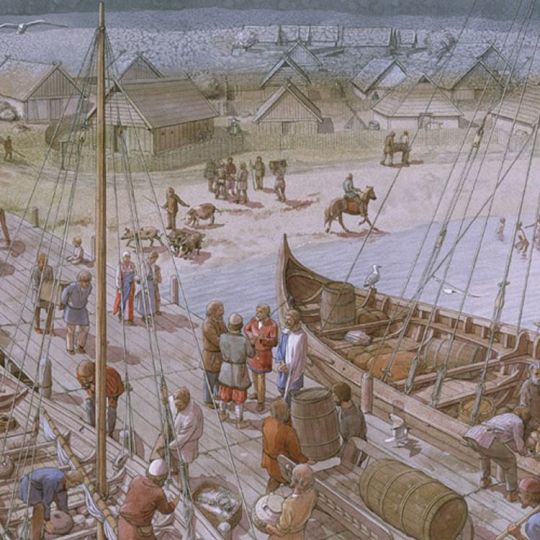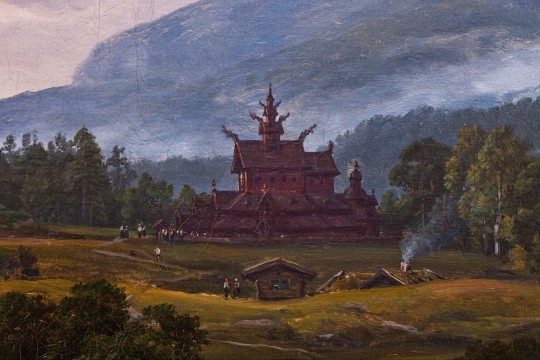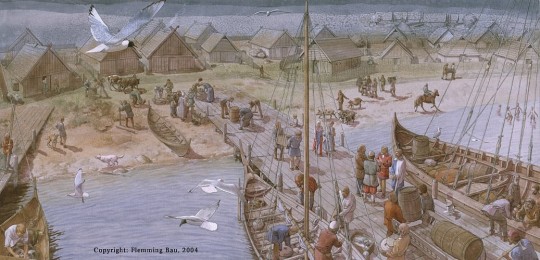#Kaupang
Photo

Kaupang
Kaupang était une ville norvégienne de l'âge des Vikings dotée d'un emporium saisonnier, établie vers l'an 780 et abandonnée vers 950. Kaupang était située sur la rive ouest de l'Oslofjord (Viksfjord) dans l'actuel comté de Vestfold, au sud-est de la Norvège, et disposait d'un accès maritime au Skagerrak. Bien qu'elle ait été beaucoup plus petite que d'autres villes vikings de Suède et du Danemark, à savoir Birka et Hedeby, Kaupang avait une importance économique pour les Vikings norvégiens et danois qui menaient des raids et faisaient du commerce avec l'Europe de l'Ouest et les îles britanniques. Kaupang peut donc se targuer d'être la plus ancienne ville de Norvège, et il s'agit probablement du même endroit que "Sciringesheal" ou "Skiringssal" (vieux norrois : Skíringssalr), qui fut visité par le marin et écrivain norvégien Ohthere de Hålogaland au 9e siècle.
Lire la suite...
2 notes
·
View notes
Photo

Hedeby
Hedeby (en nórdico antiguo: Heiðabýr; alemán: Haithabu) fue un importante bastión en la Dinamarca de la edad vikinga entre los siglos VIII-XI d.C. y, junto con Birka en la actual Suecia, fue el centro vikingo de comercio más importante de Europa. Durante esa época prosperó bajo el control de los vikingos daneses. Hoy en día, Hedeby se encuentra cerca de la ciudad de Schleswig, en Alemania, en la península de Jutlandia, pero en la Edad Media era el puerto de mercancías más septentrional de Escandinavia. Gracias a su posición favorable en el nexo entre el Imperio franco y el reino danés, así como el río Schlei que conecta con el mar Báltico, el pueblo de Hedeby amasó una gran riqueza como asentamiento mercantil con extensos vínculos comerciales con Europa occidental, Escandinavia, el este eslavo y bizantino y el mundo árabe. La UNESCO reconoció la importancia de Hedeby en la historia medieval europea y declaró el emplazamiento arqueológico un Patrimonio de la Humanidad en 2018 junto con el sistema defensivo Danevirke del que formaron parte las fortificaciones de Hedeby.
Sigue leyendo...
0 notes
Text
Mortal (film)
Benvenuti o bentornati sul nostro blog. Nello scorso articolo abbiamo deciso di cambiare genere e dall’horror siamo passati alla fantascienza, che ho sempre amato, e abbiamo discusso di una pellicola che ancora oggi continua a sorprendermi e divertirmi, Atto di forza. Douglas Quaid è un’operaio edile che da un po’ di tempo ha sogni ricorrenti su Marte e vuole andare su quel pianeta. Un giorno,…

View On WordPress
#action#adventure#André Øvredal#Arne Kaupang#Automatik Entertainment#avventura#azione#Brian Kavanaugh-Jones#cultura norrena#drammatico#Eldorado Film#Eric Bergland#fantastico#fantasy#film#Geoff Bussetil#Iben Akerlie#Marcus Paus#Mortal#Mortal film#movies#Nat Wolff#Nordisk Film Production AS#Norman Lesperance#Per Frisch#Priyanka Bose#Recensione#Recensione film#Stephen Coren#Thor
0 notes
Text

"Landskap i Kaupanger med en stavkirke" (1847) by Johan Christian Dahl
25 notes
·
View notes
Text
Historic Musuem Oslo, 2013, Part 4
Viking Age
Glass beads, Kaupang, Norway






.
Brooches

Tortoise brooch from a grave in Grimmimgdalskampen,
Vågå, Oppland, NO, 9th century
.

Tortoise brooches with a string of glass beads, Viking Age, Norway
(There was no indication whether the brooches and beads were part of the same burial / found in this particular arrangement.)

Woman's grave, tortoise brooches with string of beads and silver spiral, 9th century.
Hundorp, Sør-Fron, Oppland, Norway

Tortoise brooches, 9th century, Ringsaker, Hedmark, Norway
Glass beads, Viking Age, Hovland, Larvik, Vestfold, Norway
(Brooches and beads were NOT found in the same place!)
#glass beads#tortoise brooches#viking age#living history#viking age reenactment#historic museum oslo#glaumbaer post
52 notes
·
View notes
Link
Check out this listing I just added to my Poshmark closet: VINTAGE Souvenir Cardstock Photo Cards Stalheim Gudvangen Kaupanger M.F. 18.
0 notes
Text

Kaupang once a prosperous haven, now teeters on the precipice of ruin. After incurring Odin's WRATH, the villagers embark on a perilous journey to seek REDEMPTION. Can they regain the gods' favour? Witness their quest for salvation amidst the relentless tides of divine judgment. Main || Full Plot || Characters
0 notes
Text
I'm depressed and full of self-hatred tonight. You know what's there for me in times of woe? That's right, medieval Norse history!
More specifically, I wanted to ask you guys if this is treachery/regicide or not, because I feel like it has to be but I can't figure out how. So I'm just going to copy pretty much the whole section.
So Magnús is the grandson of my boy Harald Hardradi, and when his dad dies he is of course elected. But not everybody agrees with that, and so wannabe Hákon goes to Trondheim (it's always Trondheim, it's always. Trondheim. Thronders are always up for a rebellion. Also people named Hákon.) and gets himself elected king there, and he's popular enough, due to giving tax cuts to the rich, that people like him.
- side note, one of the concessions he grants is "He also exempted them from having to give Yule presents [to him]" and I know what the brackets are doing there but I am deeply amused by the idea that he got himself elected by exempting everyone from having to get Christmas presents for each other -
---
In the fall King Magnús journeyed north to Kaupang [in Trondheim], and when he had arrived there he went to the royal estate and dwelled there during the beginning of the winter. He kept seven warships in an open space in the ice of the Nith river in front of the royal residence. But when King Hákon learned that King Magnús had arrived in the Trondheim District he came west [north] over the Dofra Mountains to Trondheim and to Kaupang, and took lodging in the Skúli residence below Saint Clemens Church. That had been the old royal residence.
King Magnús thought ill of the great concessions which King Hákon had made to the farmers to win their favor. Magnús considered that it was no less his own property which had been given away, and he was greatly incensed about that and considered himself wronged by his kinsman in thus having so much less revenue than his father and forefathers had, and blamed Thórir [Hákon's co-conspirator] for that. King Hákon and Thórir became aware of this and were apprehensive of what measures Magnús would take. They thought it ominous that Magnús had afloat warships tented and equipped.
In spring, near Candlemas Magnús set out at dead of night and stood out with his ships tented and with lights under the tents, and sailed to Hefrin Head. There they stayed during the night, making great fires up on land.
Then King Hákon and the troops in the town thought that this was done to trick them. He had trumpets blown to call out his forces, and all the people in the town came and collected in one place. But in the morning at dawn, when King Magnús saw the assembled multitude on Eyrar Point, he sailed out of the fjord and south to the Gula Assembly District.
Then King Hákon prepared for proceeding east [south] to Vík. But before that he held a meeting in the town and there made a speech bespeaking the friendship of the people and promising to be friends with all. He said he felt much misgivings as to what King Magnús, his kinsman, intended to do. King Hákon sat on horseback, all ready to start out. Everyone vowed friendship and good will, promising to him their aid, if that was required. And all the multitude followed him out to Steinbjorg Hill [west of town].
King Hákon journeyed up to the Dofra Mountains; and one day, as he rode over the mountains, he followed after a ptarmigan which flew away from him. Then he took deadly sick and expired there on the mountain. His body was brought north and arrived in Kaupang half a month after he had left it. Then all the people of the town, most of them weeping, came to meet the body of the king, because everybody had loved him with heartfelt affection.
The body of King Hákon was interred in Christ Church. King Hákon had reached the age of about twenty-five years. He was one of the chieftains who was most beloved by all the people in Norway. He had traveled north to Permia, had fought there, and won a victory.
#Norsebinge#is it the ptarmigan? is the ptarmigan symbolic?#Hyacinth says these things just happen sometimes and it's true! they do!#but the tone here is just. SO SIMILAR to when Harald Hardradi is cheating at lots#or when somebody got a murder done to them#but that tone is also so flat and dry and prepared for you to miss the joke/intrigue#that I feel like there must be SOMETHING here#did he get ambushed in the mountains? was he poisoned?
1 note
·
View note
Text
It’s the Class War, Stupid: An Evening with Noam Chomsky
Originalmente publicado en UPROOTED PALESTINIANS: SALAM ALQUDS ALAYKUM:
APRIL 28, 2023 Photo by?Kayle Kaupanger BY?ANTHONY DIMAGGIO – RAIHAN ALAM In mid-April, we hosted renowned linguist, political analyst, and activist Noam Chomsky for a speaking and Q&A event at Lehigh University as part of the Douglas Dialogues forum. The event was attended by hundreds of students,…It’s the Class War, Stupid:…

View On WordPress
0 notes
Photo

Kaupang
Kaupang was a Norwegian Viking Age town with a seasonal emporium established around c. 780 CE and abandoned around c. 950 CE. Kaupang is located on the western side of Oslofjord (Viksfjord) in what is the present-day southeastern county Vestfold, Norway with maritime access to the Skagerrak. Alth...
Continue reading...
38 notes
·
View notes
Text

Celtic Style Fitting
simplified design from celtic style bronze fitting C57014 (unimus)
found in Kaupang, Norway
#viking age#iron age#viking age jewellery#ancient#celtic#irish#kaupang#viking#medieval#ancient civilizations#nordic#knotwork#dragon#celtic knot#archaeology#grimmborg#flat
3 notes
·
View notes
Photo

Hedeby
Hedeby (vieux norrois : Heiðabýr; allemand : Haithabu) était une importante place forte du Danemark de l'ère viking du 8e au 11e siècle. Avec Birka, dans l'actuelle Suède, c'était le plus important centre de commerce viking d'Europe. Pendant cette période, elle prospéra sous le contrôle des Vikings danois. Aujourd'hui, Hedeby est située près de la ville de Schleswig, en Allemagne, sur la péninsule du Jutland, mais elle était l'entrepôt le plus méridional de Scandinavie au début du Moyen Âge. Grâce à sa position favorable au carrefour de l'Empire franc et du royaume danois, ainsi qu'à la rivière Schlei qui rejoint la mer Baltique, la ville de Hedeby accumula une grande richesse en tant que colonie marchande ayant des liens commerciaux étendus avec l'Europe occidentale, la Scandinavie, l'Orient slave et byzantin, ainsi que le monde arabe. L'UNESCO a reconnu l'importance de Hedeby dans l'histoire de l'Europe médiévale, déclarant son site archéologique ainsi que le système défensif Danevirke dont les fortifications de Hedeby ont progressivement fait partie site du patrimoine mondial en 2018.
Lire la suite...
2 notes
·
View notes
Photo

Kaupang
Kaupang fue una ciudad noruega de la edad vikinga con un mercado estacional establecido en torno a 780 d.C. y abandonado en torno a 950 d.C. Kaupang se encuentra en el lado occidental de Fiordo de Oslo (Viksfjord) en lo que hoy en día es el condado suroriental de Vestford, en Noruega, con acceso por mar a Skagerrak. Aunque es mucho más pequeño que otras ciudades vikingas de Suecia o Dinamarca, como por ejemplo Birka o Hedeby, Kaupang era importante económicamente para los vikingos noruegos y daneses que saqueaban y comerciaban con Europa Occidental y las islas británicas. Kaupang puede reclamar ser la ciudad más antigua de Noruega, y es probablemente el mismo lugar que “Sciringesheal” o “Skiringssal” (nórdico antiguo: Skíringssalr), que fue visitado por el navegante y escritor noruego Ohthere de Hålogaland en el siglo IX.
Sigue leyendo...
0 notes
Audio
Viking Era #2
This is a soundtrack that sounds in “Pipo and the Vikings”, an educative game, that is the fifth part of the “Mathematical Time Journey” saga, directed to the childrens of 5th year in Elementary School. This is one of the many soundtracks that sound in the game and a reason I love Norway. I need to share these soundtracks.
2 notes
·
View notes
Photo

from NOS (disorder, not otherwise specified) by Aby Kaupang and Matthew Cooperman
#poetry#aby kaupang#matthew cooperman#autism#illness#experimental form#poetry inspiration#favorite poetry#the sublime#death#text
15 notes
·
View notes
Text
.Cross Pendant and Glass Beads.
A silver cross pendant and beads from a female grave at Kaupang, southern Norway. Dated to the 10th century. Shown at the Viking exhibition at the National Museum of Denmark, Copenhagen, 2013.

View On WordPress
5 notes
·
View notes